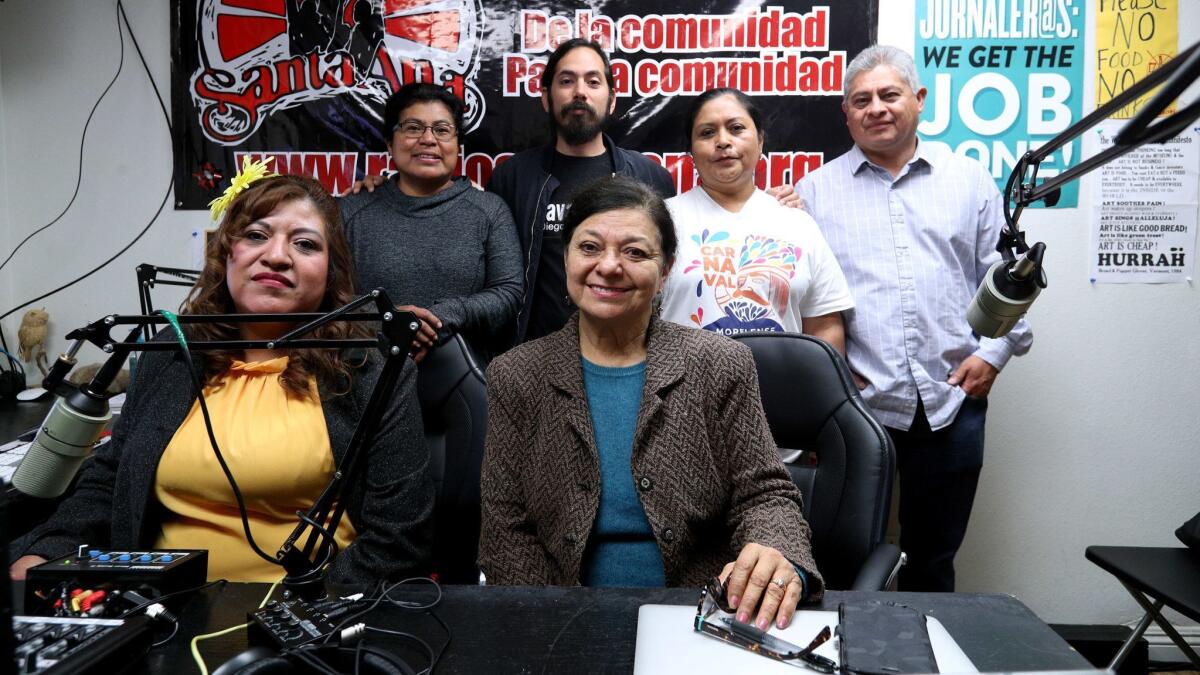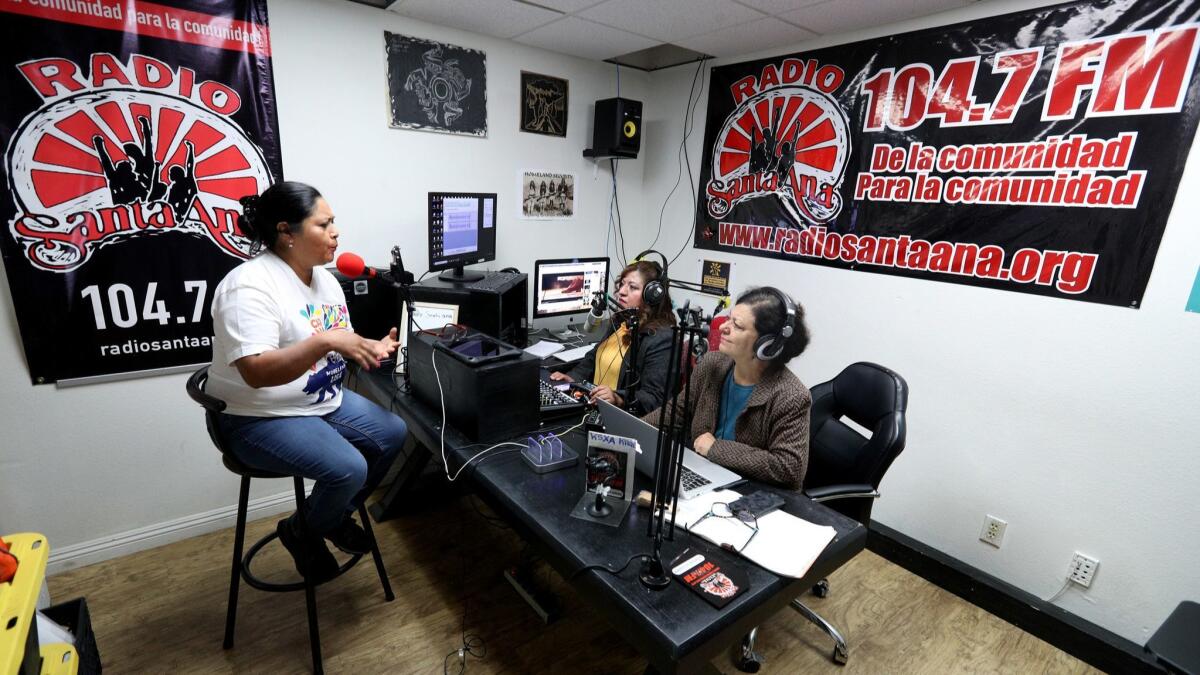Radio Santa Ana tells the otherwise unheard stories of the Latino community

- Share via
They’re on the radio, telling the stories of the unheard.
Carpenter, maintenance man, professor, community organizer. They amplify the Latino voices of Santa Ana.
Working out of a small room in the El Centro Cultural de México community center, Radio Santa Ana has for the last five years played a crucial role in advocating for the city’s underserved Latino population, covering stories and playing music that wouldn’t otherwise grace the airwaves.
“We have the really important conversations in terms of immigrant rights, the fight to access housing, youth who are doing really good work in Orange County to stop the prison-to-school-to-deportation pipeline,” said Luis Sarmiento, co-founder of the station. “A lot of those stories we don’t hear them on commercial radio or see them on the television. In our community, we see this stuff happening every day.”
Community radio stations are common worldwide. They provide grassroots coverage of issues and people generally underrepresented in traditional media. There are more than 50 such stations in Mexico, primarily in rural and indigenous regions, and many cover otherwise ignored human rights and social movements.
The challenges of getting started
“There’s a reason community radios are all over the world now—there’s perspectives that need to be known,” Sarmiento said. “The people of Santa Ana have a lot to share in terms of history, knowledge, vision for the growth of our city and for the well-being of our families. We traditionally haven’t had avenues to share that. That’s what we are trying to expose.”
Starting a community radio station can be hazardous in Mexico. Telésforo Santiago Enríquez, a community radio host, was allegedly ambushed by armed men and killed last week while on his way to host his show in Oaxaca.
Sarmiento was in Veracruz, Mexico, working with a community radio station prior to coming to Santa Ana
“Worldwide, there is a movement of communities using community radios as a way of telling their side of the story,” Sarmiento said. “They communicate what is there that needs to be protected from the community’s perspective. Coming from that experience, and learning so much from working with these folks, I jumped at the opportunity to come be a part of something in Santa Ana.”
Getting Radio Santa Ana up and running wasn’t easy.
The application process was competitive and took years. During that period, 2014-18, the group broadcast over the internet.
Considering it largely runs off donations, the station couldn’t afford a satellite dish, finally renting one for $1,200 a month.
The radio station crew remembers with pride the day the satellite dish was installed in June at the top of a freeway-adjacent radio tower near the train station.
“It was really hot that day,” said Radio Santa Ana host Ester Hernandez, a Cal State Los Angeles professor.
The station broadcasts 24/7 with eight live and three prerecorded programs on 104.7 FM. Shows are produced by a team of about 20 volunteers.
Socorro Sarmiento, who co-founded El Centro with her son, hosts “Radio Sin Fronteras,” or “Radio Without Borders,” at 7 p.m. Tuesdays. She focuses on community events and projects between partnering groups in Santa Ana, Mexico and El Salvador.
Socorro Sarmiento lectures at the UC Irvine School of Medicine when not working with the radio station.
When Rodolfo Martinez isn’t working as a maintenance supervisor, he hosts “Rock del Centro” at 5 p.m. Wednesdays. He plays music from Mexican bands, many of them local.
“Even on Spanish stations nobody is playing this music,” Martinez said.
Other longtime station staff includes Angel “Ozzy” Saucedo, a carpenter, and Reyna Mendoza, a small business owner.

In addition to highlighting important cultural events like Día del Niño, or Day of the Child, the radio station focuses on news that affects Santa Ana’s working class.
As a result of President Trump’s crackdown on immigration, the station has focused on the reunification of families separated at the border. The center regularly hosts reunification events, which are covered by the radio station. The next is May 24.
“We interview some people who haven’t seen their mother or father for 20 years,” Socorro Sarmiento said. “We are all crying when we are doing the interviews.”
Other on-air topics include the environment, schools and economic development.
“We are not a one-issue community,” Hernandez said. “We care about immigration issues, but we are also people who are concerned with the quality of life in our community. We are more than immigrants.”
The radio station is now entrenched. As people pass, they pop in to talk about an event or fundraiser.
A place for the community to gather
Community workshops are common. About 20 women attended a workshop recently where they learned about recording, editing and how to put together a program.
Most of the attendees were immigrant mothers.
“There was this woman who works cleaning houses, and she was excited to have the opportunity to share her story and experiences with other women,” Hernandez said. “She said she’d like to do a radio show. ‘It’s OK to dream,’ she said.”
Hernandez called the woman an example of “somebody who didn’t have access to these tools and now she does. She’s not only dreaming anymore.”
The group is also planning on hosting a summer program for kids.
Maintaining the station hasn’t been easy, particularly financially. But the group combats a tight budget with a do-it-yourself attitude.
The crew must act as novice engineers, maintaining technical radio equipment. All equipment was put together by the group. The station’s infant days were spent with cables splayed on the conference room table, soldering fumes filling the room.
When lightning struck the satellite dish in winter, the crew figured out how to fix it.
“We’ve learned how to troubleshoot,” Luis Sarmiento said. “We have had to be very DIY here.”
To watch or listen to Radio Santa Ana coverage, visit bit.ly/2LtH8dB.
Support our coverage by becoming a digital subscriber.
For more news and features about Orange County, visit TimesOC.com or follow us on Twitter @timesocofficial.
More to Read
Get the Latinx Files newsletter
Stories that capture the multitudes within the American Latinx community.
You may occasionally receive promotional content from the Los Angeles Times.







